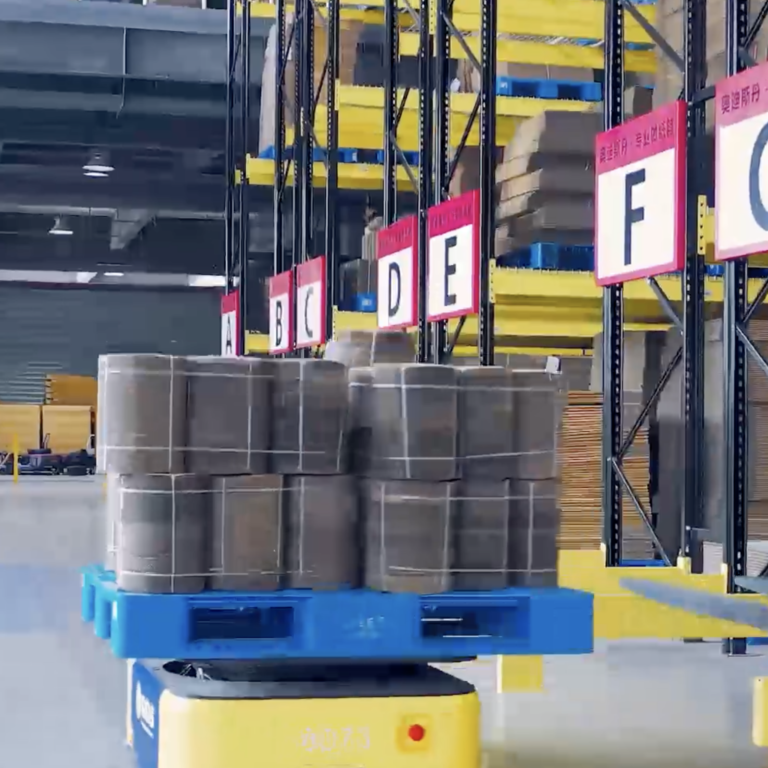5G Transformation Hub
5G Enables Digital Transformation of Manufacturing
Packaging manufacturer Hotel Star worked with China Mobile and ZTE to replace its traditional Wi-Fi-based network with a private 5G network, which can support real-time transmission of large amounts of data to the local data centre, while improving data collection efficiency, reducing deployment and maintenance costs, and increasing flexibility.
Hotel Star’s private 5G network and edge computing architecture was implemented using a “plug and play” base station solution, which integrates network, cloud and applications, provided by China Mobile.
Select a project
Contents
Challenge
With the cost of labour and raw and auxiliary materials rising, manufacturers are looking to implement lean management concepts to improve production efficiency and quality, increase customer satisfaction and boost revenues. Advanced digital technologies are now enabling manufacturing plants to become increasingly automated and efficient, but they depend on robust and reliable connectivity.
Solution
Hotel Star is using a private 5G network to support a wide variety of advanced manufacturing use cases, such as monitoring and control of automated guided vehicles, collecting real-time production data, enforcing safety and security rules, and image recognition for quality inspection. The solution, which integrates the network, the cloud and applications, is deployed by inserting a computing engine board into a 5G base station. That allows for local data offloading at base station level, while supporting the low latency, high throughput and high security required for various industrial applications.
Impact & Statistics
Following the move to 5G, Hotel Star says its equipment utilisation rate has improved by more than 20%, warehouse management efficiency has increased by 50%, and quality inspection efficiency has improved by 80%. With the reduction in manual operations, such as production data entry, Hotel Star has also been able to cut labour costs by 30%. At the same time, with the help of accurate data, overall production costs have fallen by 20%.
Wider Implications
China Mobile believes private 5G networks will enable manufacturers to achieve the modularisation and reorganisation they need to become more flexible and improve equipment utilisation. The goal is to enable a single production line to be able to build multiple products with minimal disruption. The network architecture used in the Hotel Star project is highly replicable and extensible, according to China Mobile, paving the way for other manufacturers to transform themselves“from an extensive enterprise to an intensive enterprise, and enable a new business form of 5G enabled industrial manufacturing.”
Stakeholders
Hotel Star, China Mobile and ZTE
02
5G Enables Digital Transformation of Manufacturing
Hotel Star has used 5G to help reduce overall costs in its carton production plant by 20%
In the wake of the pandemic, the cost of labour and raw and auxiliary materials has been rising, putting pressure on profit margins in the manufacturing industry. In response, manufacturers are looking to implement lean management concepts to improve production efficiency and quality, increase customer satisfaction and boost revenues.
Advanced digital technologies are now enabling manufacturing plants to become increasingly automated and efficient. Software can, for example, automatically monitor and control vehicles and machinery, enforce safety and security rules, collect real-time production data and perform quality control.
Hotel Star wanted to make much greater use of digital technologies in its carton manufacturing plant in Ningbo, in China. But many of the planned use cases, such as being able to monitor and control the status and location of portable equipment within its factory in real-time, depend on flexible and reliable connectivity and the company’s existing network wasn’t up to the task.
The Hotel Star factory has a wide variety of devices and machines that need to be connected to a diverse group of services, with low latency and high reliability. In addition, it needs to interconnect the factory network with its existing cloud-based big data platform, and seamlessly support the deployment of third-party applications, such as machine vision.
To meet these requirements cost-effectively, Hotel Star worked with China Mobile and ZTE to replace its traditional Wi-Fi-based network with a private 5G network, which can support real-time transmission of large amounts of data to the local data centre, while improving data collection efficiency, reducing wiring and maintenance costs, and increasing flexibility. To implement Hotel Star’s 5G network, China Mobile integrated network, cloud and applications into a base station using ZTE NodeEngine Pro solution. The solution interconnects internal equipment in the factory, including both production and monitoring devices.
Hotel Star is now using the 5G network and NodeEngine Pro to support a variety of advanced services, such as automated guided vehicles (AGVs), data collection, smart security protection, and image recognition. For example, Hotel Star’s connected cameras automatically inspect the quality of packaging box printing. The 5G network is used to convey the images to an image recognition system in the local data centre. Hotel Star says the accuracy of machine vision quality inspection has reached more than 97%. “Replacing human eyes with machines can effectively improve accuracy and release manpower,” says Lu Yanbo, deputy general manager of Hotel Star.
Hotel Star has also deployed a self-service portal, which enables the factory’s managers to visualise and reconfigure operations in the plant, according to a specific production plan, and reduce maintenance costs. In this way, the portal provides managers with fine-grained control over the resources in its factory. Following the move to 5G, Hotel Star says the equipment utilisation rate has improved by more than 20%, warehouse management efficiency has increased by 50%, and quality inspection efficiency has improved by 80%. With the reduction in manual operations, such as production data entry, Hotel Star has also been able to cut labour costs by 30%. At the same time, with the help of accurate data, overall production costs have fallen by 20%.
Manufacturers have traditionally relied on staff to enforce safety and security rules, but this approach is inefficient. The 5G connectivity has enabled Hotel Star to create a virtual fence, which sounds an alarm when objects or personnel enter a high-risk area by mistake. The virtual fence can also be configured to automatically halt production machines in the event of an intrusion. The virtual fence is supplemented by a high-altitude monitoring camera positioned at the top of Hotel Star’s warehouse. The camera transmits real-time video through the 5G network to monitor the overall situation of the factory.

03
5G brings greater reliability and flexibility
China Mobile says a private 5G network offers several advantages over a wired or Wi-Fi-based alternative. Wired networks are both expensive to deploy and inflexible, whereas Wi-Fi operates in unlicensed spectrum
“Based on licensed frequency bands, 5G provides carrier-class quality, which is more secure and reliable than Wi-Fi, reduces interference, and guarantees network quality,” explains Deng Wei, deputy director of Wireless and Terminal Research Institute of China Mobile. “A 5G network can support high throughput, mass connection support, minimal delay and high reliability.”
The reliability of 5G is particularly important in a manufacturing context. For example, Hotel Star’s factory has been able to “greatly reduce the connection drop rate of small vehicles and guarantee control delay,” adds Lu Yanbo. “The comprehensive 5G coverage enables AGV and other portal equipment to stay connected seamlessly across the factory.”
Thanks to the high speed and the low latency of the 5G network, the work orders of the factory’s ERP (enterprise resource planning) and WMS (warehouse management) systems can be delivered to AGVs in real time so that carton materials can be transferred in a timely and efficient manner. This approach is used to precisely manage more than 3,000 storage racks.
“The internal computing power of the base station solution with network, cloud and applications integration can be used to manage the driving routes of multiple AGVs in a unified and collaborative manner and build cloud-based AGVs to implement high-speed and stable operation of transportation operations and scheduling control, effectively improving transportation and production efficiency,” says Bai Gang, vice president of ZTE.
As it is more stable and reliable than Wi-Fi, the private 5G network has also improved the efficiency of data collection. Furthermore, the 5G network requires fewer cables than a Wi-Fi network, allowing for fast and flexible deployments, and making it easier to maintain, according to China Mobile.
With an on-site user plane function (UPF), the edge architecture deployed by Hotel Star is designed to deliver further advantages. “The data can be transmitted directly from the base station to Hotel Star’s data centre, which further reduces the delay compared with the conventional 5G core/UPF data offloading method,” explains Bai Gang. “After the data is collected, it is directly sent to the local network and effectively isolated from the public network.” Supported by an advanced service quality assurance module, this architecture is robust enough to support 10ms latency and 99.999% reliability at the same time, according to China Mobile.


Bai Gang
Vice President of ZTE
04
A high level of integration
Designed to be a one-stop-shop solution to simplify 5G private networks, the NodeEngine Pro integrates a private network, cloud computing power, and enterprise applications into a single base station. China Mobile says this has four advantages: controllable cost, agile deployment, integrated services, and rich capabilities.
The integrated solution is deployed by inserting a computing engine board into a 5G base station. That allows for local data offloading at base station level, while supporting the low latency and high security required for various industrial applications. China Mobile says the solution can be used to create a “plug-and-play local private network”, without the need for a site survey or adding new equipment room space.
“The solution can be built as a new kind of informatisation infrastructure that integrates network connection, computing power, and capability exposure, providing possibilities for supporting an infinite variety of application scenarios in the future,” says Bai Gang. “Its network architecture is simple and convenient for debugging, and can perfectly meet flexible production requirements, bringing better input-output ratio.”
Whereas a conventional private network could take two months to build, China Mobile says its solution enables a 5G private network to be deployed in just two hours, effectively shortening the construction time of enterprises and increasing production efficiency. The solution is also designed to provide a computing environment for the deployment of third-party apps in enterprise sites, while cost-effectively meeting the information needs of small and medium-sized enterprises.

05
Enabling more flexible businesses
China Mobile believes private 5G networks will enable manufacturers to achieve the modularisation and reorganisation they need to become more flexible and improve equipment utilisation. The goal is to enable a single production line to be able to build multiple products with minimal disruption.
The network architecture used in the Hotel Star project is highly replicable and extensible, according to China Mobile, thus providing valuable reference and strong technical support for the transformation of other factories.
The new integrated solution encompasses ready-made functional packages that businesses can select to support various industrial applications. For example, these packages can be used to expand wireless positioning, enhance quality of service, implement cross layer optimization and other functions.
China Mobile plans to deploy an advanced cloud-based programmable logic controller (PLC) service to replace the various manual control bus interfaces that are widely used in manufacturing. Through the “embedded deployment” of relevant apps, China Mobile is aiming to greatly improve work efficiency and reduce costs. “At the same time, the endogenous function provided by the integrated solution can provide deterministic service quality assurance for PLC operation, fully meeting the needs of real-time remote control,” explains Bai Gang. “The distributed computing power of it can be uniformly scheduled to flexibly match the flexible production demand.”
The widespread deployment of the new integrated solution will help more enterprises to complete the transformation from “extensive enterprises to intensive enterprises”, according to Deng Wei of China Mobile. “By copying the construction mode of 5G fully connected factories, it will complete the intelligent upgrading of the whole process of production and manufacturing, maximise resource allocation efficiency, and construct a new business form of 5G-enabled industrial manufacturing.”

06
About
About the GSMA
The GSMA is a global organisation unifying the mobile ecosystem to discover, develop and deliver innovation foundational to positive business environments and societal change. Our vision is to unlock the full power of connectivity so that people,
industry, and society thrive. Representing mobile operators and organisations across the mobile ecosystem and adjacent industries, the GSMA delivers for its members across three broad pillars: Connectivity for Good, Industry Services and Solutions, and Outreach. This activity includes advancing policy, tackling today’s biggest societal challenges, underpinning the technology and interoperability that make mobile work, and providing the world’s largest platform to convene the mobile ecosystem at the MWC and M360 series of events.
For more information, please visit the GSMA corporate website at www.gsma.com.
Follow the GSMA on Twitter: @GSMA.
GSMA 5G Transformation Hub
The GSMA 5G Transformation Hub is a source of information on some of the most innovative 5G solutions in the world. This portal contains case studies detailing design, benefits, key players, measured value and the future impact of scaling up these 5G solutions worldwide. The 5G Era is now firmly established and this family of standardised GSM technologies, including mmWave, are being rolled out successfully across the globe. The GSMA 5G Transformation Hub, launched at MWC Barcelona in 2022, provides details of how 5G is best placed to deliver real value for a range of key sectors including manufacturing, energy, transportation, media and live entertainment, smart cities and construction.. Many more case studies will be added, in the coming months, covering even more industries and the GSMA is asking Members to nominate innovative 5G case studies to add to this global digital showcase. The 5G Transformation Hub is sponsored by Qualcomm.
About this case study
This case study is for information only and is provided as is. The GSM Association makes no representations and gives no warranties or undertakings (express or implied) with respect to the study and does not accept any responsibility for , and hereby disclaims any liability for the accuracy or completeness or timeliness of the information contained in this document. Any use of the study is at the users own risk and the user assumes liability for any third party claims associated with such use.